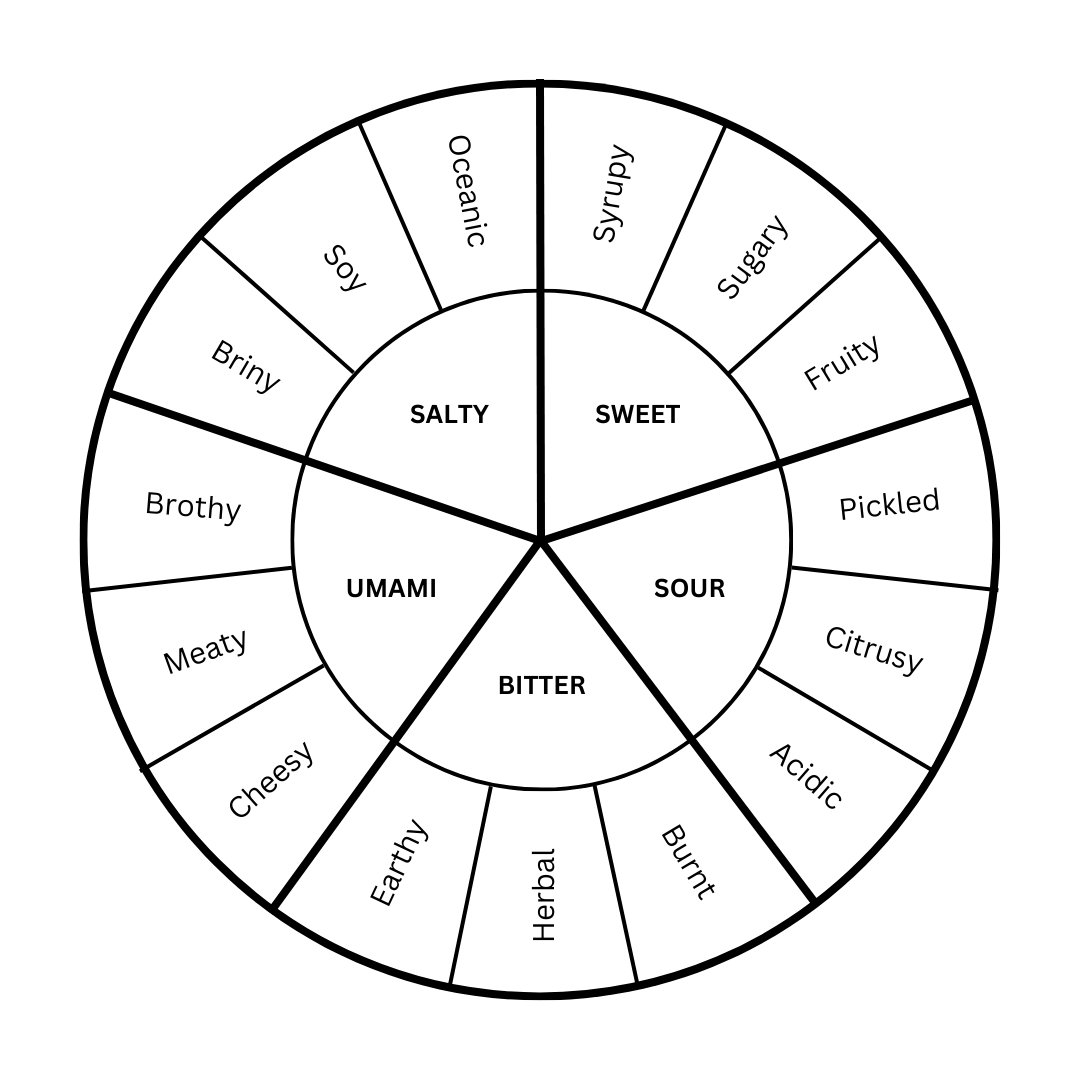We’ve all heard people talk about the flavor profile of a certain wine or coffee blend, but how are these flavors actually categorised? The flavor wheel is a handy visual tool for identifying distinct sensory attributes and putting words to the nuanced taste sensations we experience. In this way, it provides a shared vocabulary for communicating about and studying flavor. First developed by the sensory chemist Ann C. Noble in the 1980s as an aid to distinguish the complex aromas in wine, customised flavor wheels are now commonly used by professionals and enthusiasts across many different industries, including coffee, cheese, and olive oil.
Each distinct sensory category is given a slice of the wheel, which is then sub-divided into more and more specific descriptions. Often, distinctions between flavors arise from their chemical make-up. The chemical compounds in food interact with sensory receptors in your taste buds that send signals to the brain. At the same time, chewing releases chemicals that travel up into your nose. The receptors in your nose work together with those in your taste buds to create the specific, unique flavor that you experience.
While flavor wheels are traditionally used to describe more complex and subtle sensory attributes, we’ve created a simple wheel as a tool to explore the foundations of flavor—the five basic tastes, salty, sweet, sour, bitter, and umami—and the chemistry behind them.


Salty
Saltiness is a chief characteristic of savoury foods. The salty taste profile includes briny flavors like capers and processed meats, soy-like flavors such as miso and soy sauce, and oceanic flavors like caviar and smoked salmon. Saltiness also comprises metallic, cheesy, or mineral-like attributes. Long before refrigeration—as far back as Ancient Egypt—salt was used as a preservative, pulling out the moisture from food to prevent bacterial growth. Similarly, we use salt today in the cooking process to enhance the other natural flavors in food by drawing out water, thereby increasing the flavor concentration.
A salty taste is typically associated with sodium chloride (table salt) or other mineral salts like potassium chloride. Sodium chloride is obtained for everyday use through seawater evaporation and salt mining. Aside from its culinary uses, sodium plays vital roles in the human body: it balances the distribution of water, blood, and electrolytes in our system, helps muscles to contract, and allows cells to communicate. It’s generally believed that we’re able to taste saltiness so that we can make sure to ingest enough sodium to keep our body functioning as it should.
.jpg)
Sodium chloride
.jpg)
Molecular structure of table salt

Sweet
Sweetness primarily comprises syrupy, sugary, and fruity flavors. Honey and caramel constitute syrupy sensations, while candy and ice cream produce sugary flavors, and berries, bananas, grapes, and the like are associated with fruitiness. Typically, sweetness is conferred by sugars like sucrose (table sugar) and fructose as well as artificial sweeteners such as saccharin and aspartame. The presence of “sweet” amino acids (d-serine, d-tryptophan, d-phenylalanine) and proteins (monellin, thaumatin, brazzein) also contributes to our perception of these flavors. Researchers suspect that the stronger the hydrogen bonds between sugar molecules and neighbouring compounds, the sweeter the substance; for instance, fructose is the sweetest-tasting sugar and forms the strongest hydrogen bonds with water.
From an evolutionary standpoint, scientists believe that we have developed a liking for sweet-tasting foods because these are often rich in carbohydrates, a good source of fuel for our bodies. However, it’s important to note that sweet can also mean dangerous—some toxic compounds like chloroform are sweet, and certain harmful bacteria like Pseudomonas also create a sweet taste in the mouth.
.jpg)
.jpg)
Sucrose
.jpg)
.jpg)
Saccharin

Sour
Sourness is usually a slight to intense acidic (vinegar, sour cream, yoghurt), citrusy (lemons, limes, oranges), or pickled (sauerkraut, pickled ginger) taste that can also be described as tangy, zesty, or tart. The sensation of sourness is mostly associated with organic acids that have a carboxyl group (COOH), such as citric, acetic, malic, and lactic acid. Unlike sweetness, which may result from various types of chemicals, only acidic compounds are sour, a sensation caused by their high concentration of hydrogen ions (low pH).
Interestingly, all vertebrates can recognise acidic foods, suggesting that this trait has evolutionary importance. Despite this, the biological reason behind the human ability to taste sourness is not well understood. Some think that since our ancestors lost the ability to produce vitamin C millions of years ago, sourness helps us keep our health in check by allowing us to gauge the amount of vitamin C in the foods we eat.
.jpg)
.jpg)
Citric acid
.jpg)
.jpg)
Malic acid

Bitter
Bitter tastes are polarising: some people hate them, while others obsess over the strong flavors of espresso or dark chocolate. Bitterness is associated with herbal flavors like those of rocket (arugula) and green tea, the earthy tastes found in olives and cruciferous vegetables like kale and broccoli, and the burnt flavors characteristic of roasted coffee beans or chargrilled meat. Bitterness is commonly linked to the presence of alkaloids such as caffeine, quinine, and naringin, as well as polyphenols and flavonoids. In fact, over 1300 bitter-tasting chemicals have been recorded in the database BitterDB.
It is no coincidence that many plant-derived flavors are bitter. Plants use bitterness as protection from predators, and many that contain bitter compounds are toxic to humans too. It’s generally accepted that we evolved to taste bitterness so that we could avoid poisonous flora. Contrary to popular belief, there are no specific “zones” of the tongue that sense different flavors; the entire tongue can detect all five basic tastes. However, the back of the tongue is especially sensitive to bitterness, which is thought to help us recognise toxic foods before we ingest them.
.jpg)
.jpg)
Caffeine
.jpg)
.jpg)
Naringin

Umami
Umami was discovered in Japan over 100 years ago and is synonymous with savouriness. The most complex of the basic tastes, umami-like foods are brothy, such as minestrone soup or ramen broth, meaty, like pork, seafood, and mushrooms, and cheesy, like aged parmesan or Swiss cheese. Tomatoes and some fermented foods like kimchi are also rich in umami flavor. Umami-tasting foods are usually high in protein and contain the amino acid glutamate and/or the nucleotides inosinate and guanylate. These compounds are also frequently used as flavor additives or as salt substitutes in low-sodium foods.
A common form of glutamate is the controversial compound MSG (monosodium glutamate). MSG, which occurs naturally but is also added to food in many Asian recipes, gained a bad reputation in the 1960s when it was associated with “Chinese restaurant syndrome”. This was sparked by a Chinese-American physician who described feeling sick after eating Chinese food. Today, scientists generally recognise MSG as being safe in moderation. Past misinformation about the compound was likely fuelled by prejudice against Chinese US immigrants at the time.
.jpg)
.jpg)
Monosodium glutamate (MSG)
.jpg)
.jpg)
Guanylate
Conclusion
As you may already suspect, most foods can be described by more than one basic taste: many fruits are both sweet and sour; most meats have salty and umami attributes. While our simple flavor wheel compartmentalises the five basic tastes, in reality, flavor classifications are far more numerous, complex, overlapping, and subjective. However, these basic tastes play a fundamental role in our sensory experience and understanding them can enrich our overall appreciation of flavor chemistry and the culinary world.
The five-taste wheel provides a starting point for learning to classify the intricate array of flavors out there, be they the botanical notes in a new brand of honey or the smokiness of your favourite barbecue sauce.
Chemical structures were created using MolView and The Materials Project.



